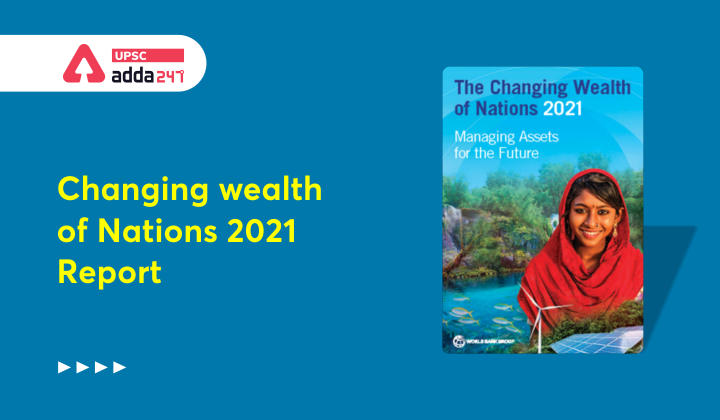Table of Contents
Changing Wealth of Nations Report 2021: Relevance
- GS 2: Important International institutions, agencies and fora – their structure, mandate.
Changing Wealth of Nations Report 2021: Context
- World Bank has released a new report titled, ‘Changing Wealth of Nations’ that reveals that global wealth has grown overall—but at the expense of future prosperity and by exacerbating inequalities.
Have you cleared UPSC CSE Prelims 2021? Register Here for Free Study Material
Changing Wealth of Nations Report 2021: Key points
- The Changing Wealth of Nations 2021 tracks the wealth of 146 countries between 1995 and 2018, by
- measuring the economic value of renewable natural capital (such as forests, cropland, and ocean resources),
- non-renewable natural capital (such as minerals and fossil fuels),
- human capital (earnings over a person’s lifetime),
- produced capital (such as buildings and infrastructure), and
- net foreign assets.
- The report accounts for blue natural capital—in the form of mangroves and ocean fisheries—for the first time.
Changing Wealth of Nations Report 2021: Key findings
- Countries that are depleting their resources in favor of short-term gains are putting their economies on an unsustainable development path.
- While indicators such as Gross Domestic Product (GDP) are traditionally used to measure economic growth, the report argues for the importance of considering natural, human, and produced capital to understand whether growth is sustainable.
Growth vs Natural Resources
- According to the report, global wealth grew significantly between 1995 and 2018, and middle-income countries are catching up to high-income countries.
- However, growing prosperity has been accompanied by unsustainable management of some natural assets.
- Low- and middle-income countries saw their forest wealth per capita decline 8% from 1995 to 2018, reflecting significant deforestation.
- Meanwhile, the value of global marine fish stocks collapsed by 83% due to poor management and overfishing over the same period. The projected impacts of climate change may exacerbate these trends.
- Mispricing of assets like carbon-emitting fossil fuels can lead to overvaluation and over-consumption.
Inequality
- The report has indicated that global wealth inequality is growing.
- Low-income countries’ share of global wealth has changed little from 1995 to 2018, remaining below 1% of the world’s wealth, despite having around 8% of the world’s population.
- Over one-third of low-income countries saw declining wealth per capita.
- Countries with declining wealth tend also to be degrading their base of renewable natural
Renewable energy
- Globally, the share of total wealth in renewable natural capital (forests, cropland, and ocean resources) is decreasing and being further threatened by climate change.
- At the same time, renewable natural capital is becoming more valuable as it provides crucial ecosystem services.
- For example, the value of mangroves for coastal flood protection has grown more than 2.5 times since 1995 to over $547 billion in 2018.
- The value of protected areas per square kilometer has also rapidly increased.
Regional trends: South Asia
- In South Asia, total wealth has grown since 1995, but due to population growth in the same time period, per capita wealth remains among the lowest in the world.
- Human capital makes up over half of the region’s wealth, but is extremely unbalanced, with over 80% attributed to men, with little change in the past two decades.
- If gender parity was achieved in South Asia, this could increase human capital nationally by roughly 42 percentage points.
- As a region, South Asia is also most severely affected by the estimated loss of human capital due to air pollution.
- Renewable natural capital, particularly cropland, is vital for South Asia, and the value of its blue natural capital also grew over the past two decades.
Recently released reports about socio-economic conditionof the world
UNESCO State of Education Report 2021
The Least Developed Countries Report 2021




 TSPSC Group 1 Question Paper 2024, Downl...
TSPSC Group 1 Question Paper 2024, Downl...
 TSPSC Group 1 Answer key 2024 Out, Downl...
TSPSC Group 1 Answer key 2024 Out, Downl...
 Cabinet Ministers of India 2024, New Cab...
Cabinet Ministers of India 2024, New Cab...







